Early Recordings

The earliest usable recordings begin in 1889, and used three different technologies, Edison cylinders, phonograph discs, and reproducing piano and organ rolls. This variety is important, since each has its limitations. It’s exciting that over the last decade or so recordings long thought lost have been have been rediscovered, including an amazing collection of cylinders organised by German industrialist Julius Block, recorded from 1890 - 1927. From this HIP Aladin’s Cave we now have a more accurate understanding of late romantic style than for any previous era.


Imagine if you could hear Bach improvising on the organ, or Beethoven interpreting his own sonatas. HIP scholars of the baroque and classic eras would sacrifice whole herds of fatted calves for such an opportunity! Sadly, it’s not possible, but we CAN hear recordings by early 20th century composers, and almost hear recordings by the great romantic composers through their students, and through others who knew how they played. Most important (and numerous) are the students of Franz Liszt, regarded as the greatest romantic pianist. Here is a sample:
And there’s even better news: many of these recordings have been uploaded to YouTube. Here are some suggestions to get you started:
Joachim (friend of Brahms), 1903: https://youtu.be/lV_YXtUs_Ow
Sophie Menter (student of Liszt, piano roll), 1905: https://youtu.be/cfdaQv1qpwI
Scriabin (piano roll), 1910: https://youtu.be/VK2uTtuI84w
Friedrich Kark (conductor), 1910: https://youtu.be/nVbgz9kZeD0
Nikisch (conductor), 1913: https://youtu.be/XuFReWTLMm0
Debussy collection, 1904-13 (piano rolls plus discs): https://youtu.be/W2fgqT8wtcY
Rosenthal (student of Liszt), 1929: https://youtu.be/X77Nm1nrcG8
Prokofiev collection, 1935: https://youtu.be/Gk0jJyUh0T4

Welte- Mignon roll mechanism
